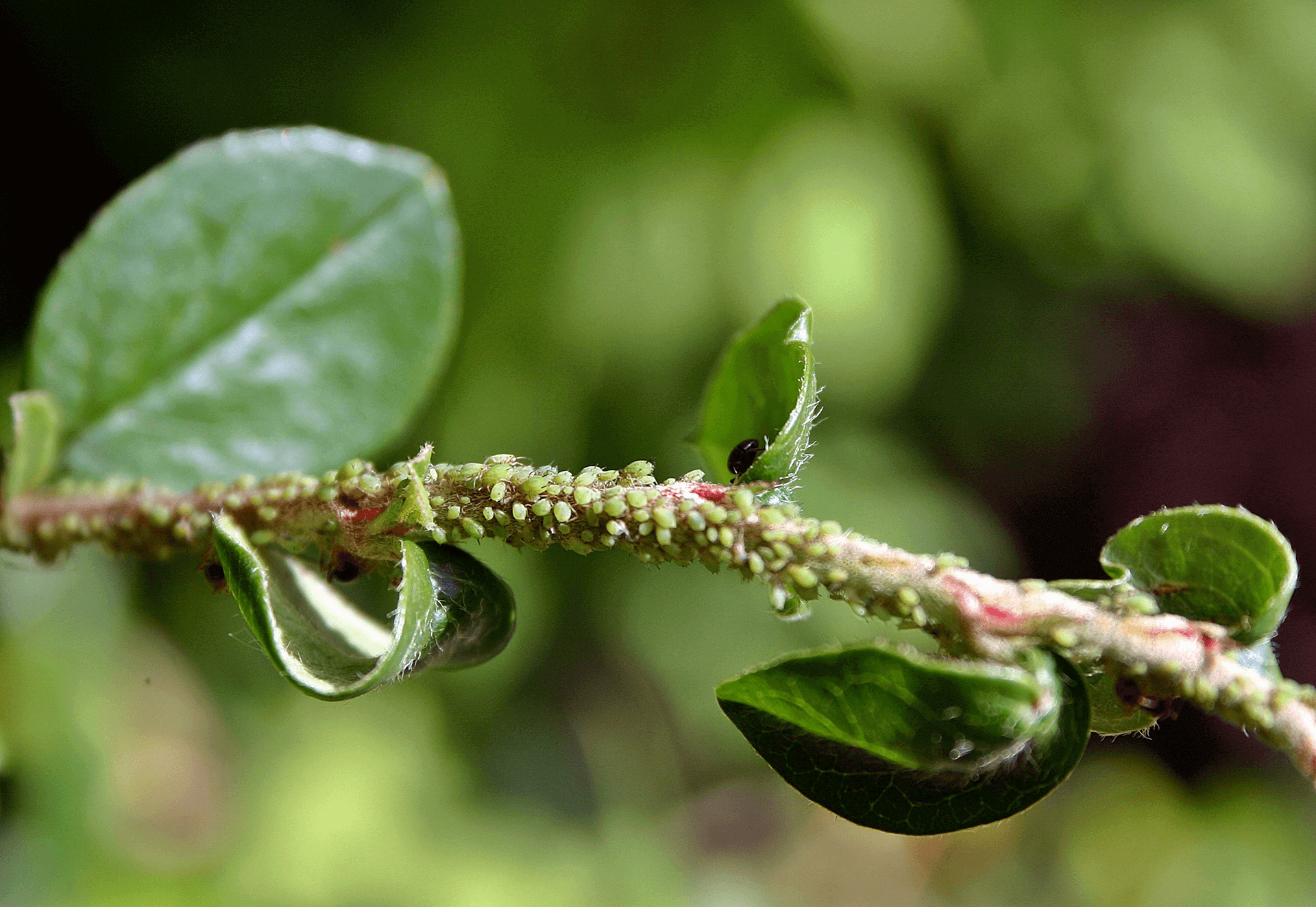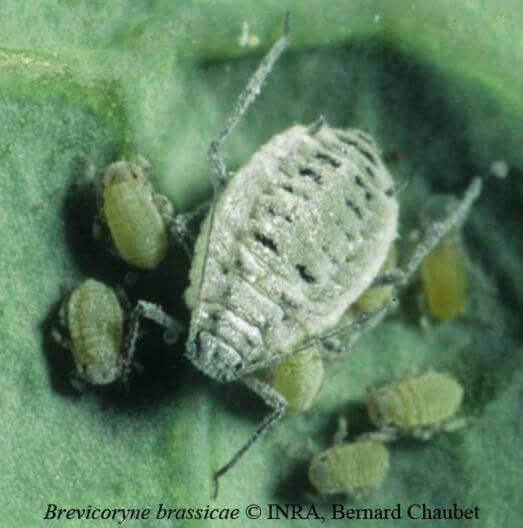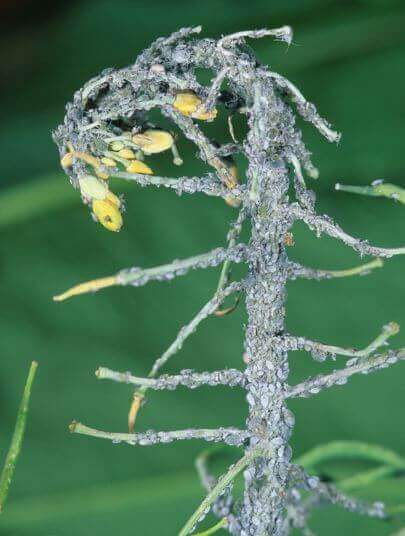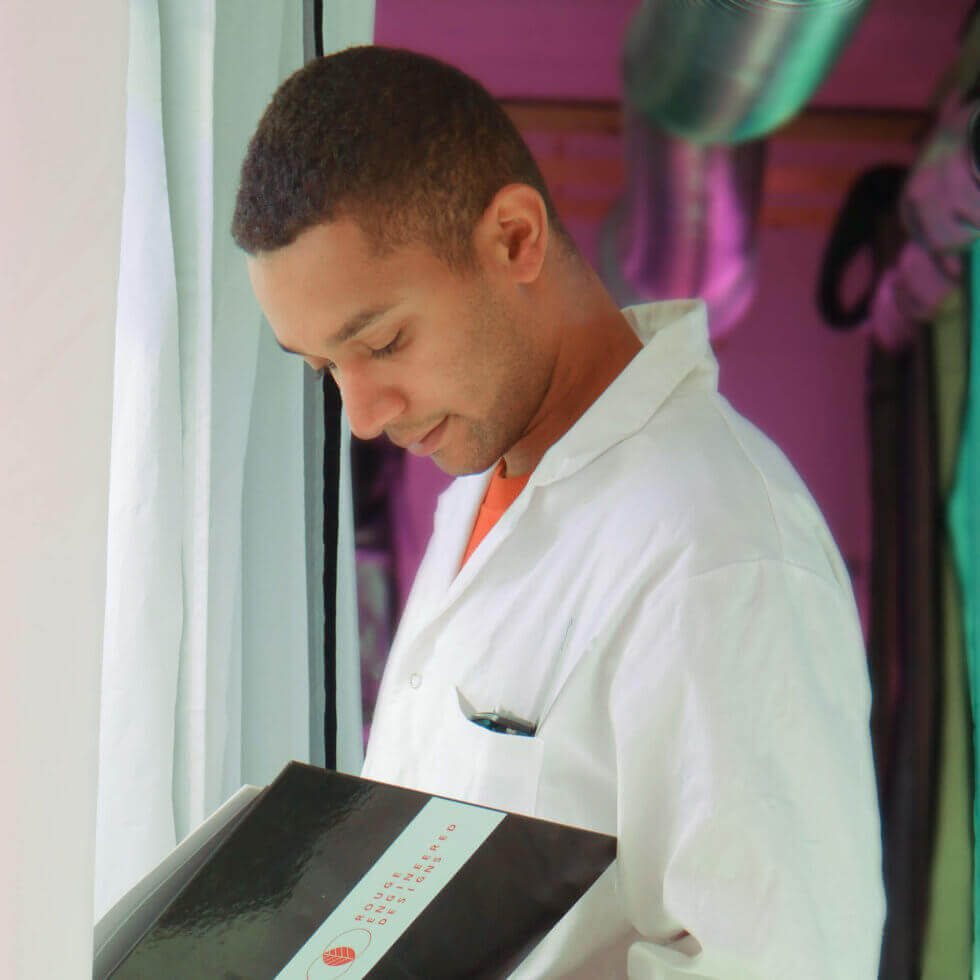
Light to limit aphid’s infestation.
Aphids are one of the most common and damaging insect pests of crops. They can reduce yields by up to 20%, as plant growth is slowed and fruiting is poor.
14 November 2023
The Ecophyto plan requires French agriculture to reduce the use of phytosanitary products by 50% by 2025. It is therefore necessary to find other solutions for controlling these pests.
Controlled light management is an alternative solution for controlling aphids. Light can modify the development and behavior of these insects. It can also hinder their development by modifying plant metabolism.

Complex parameters affecting their behaviour.
Figure 1: cabbage aphid Brevicoryne brassicae
Source: Turpeau, Hullé and Chaubet, 2010a
As with many insects, UV rays are essential for aphids to take off, fly and detect host plants. It has recently been shown that the presence of UV-A in light is essential for their vision. Thus, the absence of UV in a cucumber crop delays the appearance of aphids and limits infestation.
The effects of light on aphids depends on the species in question. UV-A and B have no effect on the fecundity of Myzus persicae, while it is reduced in the case of the cabbage aphid Brevicoryne brassicae. We can therefore observe a genotype effect in reactions to light.
Furthermore, aphids prefer yellow light to red and green light, as this wavelength invites them to land. Indeed, aphids are vectors of viruses and would be attracted by yellowing leaves, the sign of a diseased plant. Finally, light intensity also has an impact on aphids: its reduction reduces the size of the progeny of several aphid species.
Indirect action to reinforce plant defenses.
Aphids are biting-sucking insects: their proboscis* penetrates plant cells to feed.
Multiple wavelengths stimulate the plant’s defense system by promoting the production of specific secondary metabolites. Ingestion of some of these molecules by aphids reduces their fecundity. It should be noted, however, that these effects vary according to the aphid species in question. For example, in Brussels sprouts, blue light promotes the production of a particular molecule that increases the fecundity of Brevicoryne brassicae. The impact of light on plants can also favour the establishment of these insects. Studies show that plants exposed to UV-A light have a higher nitrogen content. As this element is essential to their nutrition, aphids are attracted to these plants. Similarly, cabbage aphids preferentially target plants grown under blue light. This wavelength increases chlorophyll concentration and promotes photosynthesis, making these plants more attractive to these insects.

Light as an alternative for crop protection.
Figure 2: Brevicoryne brassicae damage on oilseed rape
Source: Turpeau, Hullé and Chaubet, 2010a
Optimum lighting management not only increases yield and improves quality, but also protects plants, particularly against aphids. It’s essential to think about light management in an integrative way, so as to take into account the different effects of wavelengths and match them to production objectives. Technological advances now enable day-to-day control of luminaires and direct adaptation of spectra, thus ensuring a high degree of precision in controlling aphid populations.
Studies on this subject are still few and far between and need to be further investigated in order to determine optimal solutions for managing aphid colonies using light.
* Rostre: mouthpiece used by certain insects to pierce plant epidermis and suck nutrients from plant cells.
Bibliography
Acharya, J., Rechner, O., Neugart, S., Schreiner, M. and Poelhing, H.-M., 2016. Effects of light-emitting diode treatment on secondary metabolite-mediated performance of Brevicoryne brassicae in Brussels sprouts. In: Journal of Plant Diseases and Protection. Vol. 123, (6), pp. 321 – 330. DOI 10.1007/s41348-016-0029-9
Dader, B., Gwynn-Jones, D., Moreno, A., Winters, A. and Fereres, A., 2014. Impact of UV-A radiation ond the performance of aphids and whiteflies ond on the leaf chemistry of their host plants. In: Journal of Photochemistry and Photobiology B: Biology. Vol. 138, p. 307 – 316. DOI 10.1016/j.jphotobiol.2014.06.009
Döring, 2014. How aphids find their host plants, and how they don’t. In: Annals of Applied Biology. Vol. 165, pp. 3 – 26. DOI 10.1111/aab.12142
Elfadly, E., Abd El-Aal, H., Rizk, A. and Sobeih, W., 2016. Ambient UV manipulation in greenhouses: plant responses and insect pest management in cucumber. In: VIII International Symposium on Light in Horticulture. East Lansing, Michigan, USA. 2016. p. 343 – 350. DOI 10.17660/ActaHortic.2016.1134.45
Johansen, N. S., Vänninen, I., Pinto, D. M., Nissinen, A. I. and Shipp, L., 2011. Inthe light of new greenhouse technologies: 2. Direct effects of artificial lighting on arthropods and integrated pest management in greenhouse crops. In: Annals of Applied Biology. Vol. 159, (1), p. 1 – 27. DOI 10.1111/j.1744-7348.2011.00483.x
French Ministry of Agriculture and Food, 2020. Le plan Écophyto, qu’est-ce que c’est ? [online]. [Accessed May 11, 2020]. Available at: https://agriculture.gouv.fr/le-plan-ecophyto-quest-ce-que-cest
Rechner, O., Neugart, S., Schreiner, M., Wu, S. and Poelhing, H.-M., 2016. Different narrow-band light ranges alter plant secondary metaboism and plant defense response to aphids. In: Journal of Chemical Ecology. Vol. 42, (10), pp. 989 – 1003. DOI 10.1007/s10886-016-0755-2
Rechner, O., Neugart, S., Schreiner, M., Wu, S. and Poehling, H.-M., 2017. Can narrow-bandwidth light from UV-A to green alter secondary plant metabolism and increase Brassica plant defenses against aphids? In: Public Library Of Science – One. Vol. 12, (11), p. 20. DOI 10.1371/journal.pone.0188522
Turpeau, E., Hullé, M. and Chaubet, B., 2010a. Brevicoryne brassicae (Linnaeus, 1758). INRAE [online]. 22 August 2018. [Accessed May 25, 2020]. Available at: https://www6.inrae.fr/encyclopedie-pucerons/Especes/Pucerons/Brevicoryne/B.-brassicae
Turpeau, E., Hullé, M. and Chaubet, B., 2010b. Aphids and agriculture – Damage. INRAE [online]. 02 December 2010. August 30, 2018. [Accessed May 27, 2020]. Available at: https://www6.inrae.fr/encyclopedie-pucerons/Pucerons-et-agriculture/Degats


